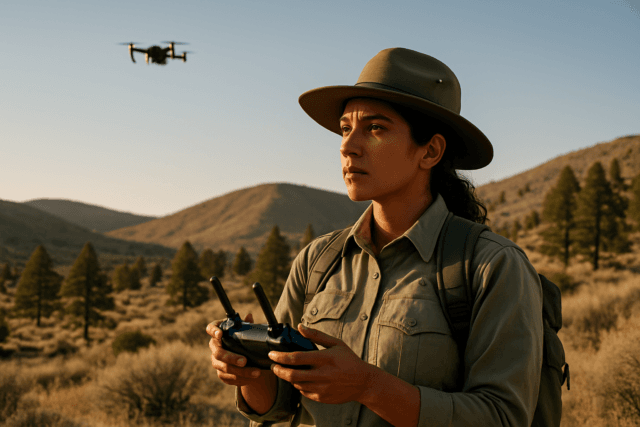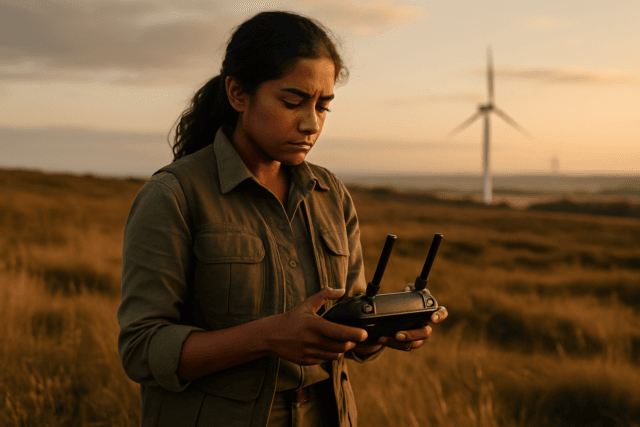The integration of Unmanned Aircraft Systems (UAS), commonly known as drones, into civilian airspace is rapidly transforming various sectors, from delivery services to infrastructure inspection. However, this integration poses significant challenges related to safety, air traffic management, and regulatory compliance. Aerobits, a Polish technology company specializing in miniaturizing avionics components, is emerging as a key player in addressing these challenges and shaping the future of unmanned aviation.
Aerobits: Revolutionizing Airspace Integration
Aerobits stands out as one of the few companies worldwide offering comprehensive solutions for safely integrating UAS into civilian airspace. Their innovative approach involves fusing technologies like ADS-B, FLARM, UAT, LTE, BLE, and Wi-Fi, along with their multichannel Ground Receiver Stations, to enable seamless communication between drones, manned aircraft, and air traffic control (ATC). Aerobits’ systems can detect the technology onboard UAS and forward the data to the airspace supervising body for informed decision-making. This open approach promotes complete and safe airspace sharing between all users.
Origins and Evolution
Founded in 2017, Aerobits’ roots trace back to 2015, when the world’s smallest ADS-B/GNSS fusion module was developed at the West Pomeranian University of Technology in Szczecin. Since then, the company has consistently innovated, forming key partnerships and expanding its global presence. Aerobits’ core products include sub-miniature ADS-B, FLARM, UAT modules, and Remote ID solutions, designed to enhance air traffic safety and facilitate the integration of UAS into controlled airspace.
Commitment to Safety and Innovation
Aerobits is committed to safety, innovation, and interoperability, and is actively shaping the future of unmanned aviation. The company’s solutions comply with FAA and EASA standards, ensuring compatibility with global airspace regulations. By miniaturizing avionics components, Aerobits enables advanced functionalities in compact UAS platforms, including:
- Detect and Avoid (DAA): Allows drones to autonomously detect nearby aircraft and take evasive action, ensuring safe operations in shared airspace.
- GNSS Integration: Enhances navigation by combining ADS-B with GNSS, providing precise positioning for autonomous flight in complex environments.
- Compact ADS-B Solutions: Enables UAVs to transmit position and altitude, improving air traffic awareness and safety.
Key Technologies and Solutions
Aerobits offers a range of technologies and solutions designed to facilitate the safe and efficient integration of UAS into civilian airspace:
ADS-B Transceivers
ADS-B (Automatic Dependent Surveillance-Broadcast) is a surveillance technology in which an aircraft determines its position via satellite navigation and periodically broadcasts it, enabling it to be tracked. Aerobits specializes in miniaturizing standard aviation-graded ADS-B transceivers, allowing them to be installed on even the smallest drones. This technology enhances air traffic awareness and enables safe integration into non-segregated airspace.
The two main functions of ADS-B systems are transmission and reception. Unlike standard transponders, ADS-B transceivers do not require interrogation. Data transmission (broadcast) is done periodically to all nearby airspace users for instant position tracking, making this technology more standalone.
Remote ID Solutions
Remote ID is a crucial component of UAS integration, allowing drones to be identified and tracked remotely. Aerobits offers advanced Remote ID solutions, including the idME PRO, which supports dual-technology broadcasting (Wi-Fi and Bluetooth) and complies with FAA and EASA standards. These solutions enhance airspace safety by enabling the detection and processing of Remote ID signals from UAVs.
Ground Infrastructure
Aerobits provides ground infrastructure for UTM/U-Space, supporting airspace surveillance and traffic management. Their solutions include:
- DRS-1 Dual-Band Receiver Station: A high-performance receiver station designed to provide reliable airspace surveillance capabilities, particularly for monitoring traffic at airports, air traffic management systems, and local airfields.
- GS2L Ground Station: A versatile device that serves as a powerful Remote ID ground receiver, offering features like ADS-B/FLARM/UAT or RID reception, PoE power supply, weather-resistant design, and easy installation and configuration.
trkME System
Aerobits’ trkME system revolutionizes UAS safety systems by offering SWaP (Size, Weight, and Power) UAS trackers that include all commonly used technologies (ADS-B, FLARM, UAT as well as LTE, Wi-Fi, and Bluetooth). This system enhances connectivity and performance, providing superior tracking for advanced operations.
Addressing the Challenges of UAS Integration
Integrating UAS into civilian airspace presents numerous challenges, including:
Regulatory Framework
The regulatory landscape for UAS operations is constantly evolving, with different regulations in place across various regions. Aerobits’ solutions comply with FAA and EASA standards, ensuring compatibility with global airspace regulations. The company also actively participates in shaping the regulatory framework for UAS integration.
In Europe, EASA (European Union Aviation Safety Agency) establishes common rules and standards for drones, while national aviation authorities (NAAs) implement and enforce these regulations within their respective jurisdictions. The European Organisation for Civil Aviation Equipment (EUROCAE) develops standards for aviation equipment and systems, including those related to drones.
Air Traffic Management
Integrating UAS into existing air traffic management systems requires careful consideration to ensure the safety of all airspace users. Aerobits’ technologies enable seamless communication between drones, manned aircraft, and air traffic control, enhancing air traffic awareness and facilitating safe separation.
UTM (Unmanned Traffic Management) is a functional extension of ATM (Air Traffic Management) that aims to integrate drones into the airspace safely. Achieving this goal requires maintaining system compatibility between manned and unmanned aviation, which can be obtained through the implementation of communication systems like ADS-B, FLARM, UAT as well as LTE, Wi-Fi, and Bluetooth.
Detect and Avoid (DAA)
Ensuring that UAS can detect and avoid collisions with other aircraft is crucial for safe integration into civilian airspace. Aerobits’ DAA solutions allow drones to autonomously detect nearby aircraft and take evasive action, ensuring safe operations in shared airspace.
Remote Identification (Remote ID)
Remote ID is essential for identifying and tracking drones, enabling authorities to monitor airspace and ensure compliance with regulations. Aerobits’ Remote ID solutions comply with FAA and EASA standards, providing a reliable means of identifying and tracking UAS.
Counter-UAS Measures
The increasing use of drones has also led to concerns about the potential for malicious use, necessitating the development of counter-UAS (C-UAS) technologies. These technologies are used to detect and mitigate the use of illegally operated drones in civilian airspace.
Benefits of Aerobits’ Solutions
Aerobits’ solutions offer numerous benefits for UAS operators, aviation regulators, and air navigation service providers:
Enhanced Safety
By providing advanced technologies for communication, navigation, and collision avoidance, Aerobits enhances the safety of UAS operations in civilian airspace.
Improved Air Traffic Management
Aerobits’ solutions facilitate seamless integration of UAS into existing air traffic management systems, improving air traffic awareness and efficiency.
Regulatory Compliance
Aerobits’ solutions comply with FAA and EASA standards, ensuring that UAS operators can meet regulatory requirements and operate legally in various regions.
Increased Efficiency
By enabling autonomous flight and remote identification, Aerobits’ solutions increase the efficiency of UAS operations, allowing for a wider range of applications.
Cost Savings
Aerobits’ miniaturized avionics components reduce the size, weight, and power consumption of UAS, leading to cost savings for operators.
Aerobits’ Global Impact
Aerobits’ technologies are currently used in over 63 countries by aviation regulators, drone manufacturers, and air navigation service providers. The company’s commitment to innovation and safety has made it a key player in shaping the future of unmanned aviation worldwide.
The Future of UAS Integration
The integration of UAS into civilian airspace is an ongoing process, with many challenges and opportunities ahead. Aerobits is committed to continuing its innovation and collaboration with industry partners to ensure the safe, efficient, and seamless integration of UAS into the global airspace system.
As UAS technology continues to evolve, Aerobits’ expertise in miniaturizing avionics components and developing advanced solutions will be crucial in enabling the full potential of unmanned aviation.





